Derby's Heritage Part 04 - The Cathedral
w/e 25 April 2010
All this week's pictures were taken
with a Kodak DX6490
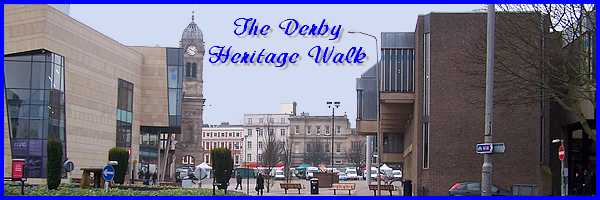
 We have already caught
sight of external views of Derby Cathedral in earlier parts and
no doubt we will also see more of the exterior from various angles
as the Heritage Walk continues around the city centre. For this
fourth part, after crossing the road from the Cathedral Centre
that we visited in Part 03, we will concentrate on the inside
of the building, pausing here only to mention the stone pre-Reformation
tower built between 1511 and 1532. At 212 feet (64m) high the
tower is second only to St Botolph's Church in Boston, Lincolnshire
(better known as the Boston Stump) as the largest perpendicular
tower in England but it houses the oldest ring of ten bells in
the world. We have already caught
sight of external views of Derby Cathedral in earlier parts and
no doubt we will also see more of the exterior from various angles
as the Heritage Walk continues around the city centre. For this
fourth part, after crossing the road from the Cathedral Centre
that we visited in Part 03, we will concentrate on the inside
of the building, pausing here only to mention the stone pre-Reformation
tower built between 1511 and 1532. At 212 feet (64m) high the
tower is second only to St Botolph's Church in Boston, Lincolnshire
(better known as the Boston Stump) as the largest perpendicular
tower in England but it houses the oldest ring of ten bells in
the world.

Formerly the Collegiate Church, All Saints' was raised to cathedral
status in 1927 when the Diocese of Derby was created. The aforementioned
tower is all that remains of the old church as the rest of the
building was rebuilt between 1723 and 1725 by Francis Smith of
Warwick to a design by architect James Gibbs, a pupil of Christopher
Wren. The nave was extended in 1968-72 but whatever its origins,
it is said that new visitors often comment on the light and airy
interior so different to older churches.
|
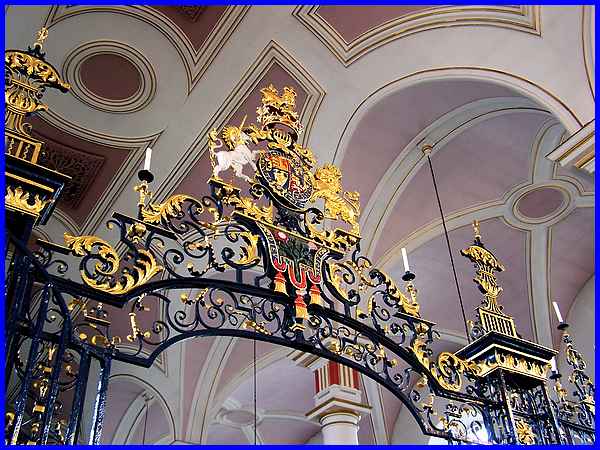
A free Walk Around Plan is available just inside the entrance
and a more detailed guide may be purchased for a nominal fee
both of which point out the main features to be seen in the cathedral.
One of those features is the Bakewell Screen which will appear
in several images on this page with the one above showing some
of the detail of the screen. The wrought iron screen, also designed
by James Gibbs, dates from 1736 and was made by Robert Bakewell
of Melbourne, a celebrated eighteenth century ironsmith.
|
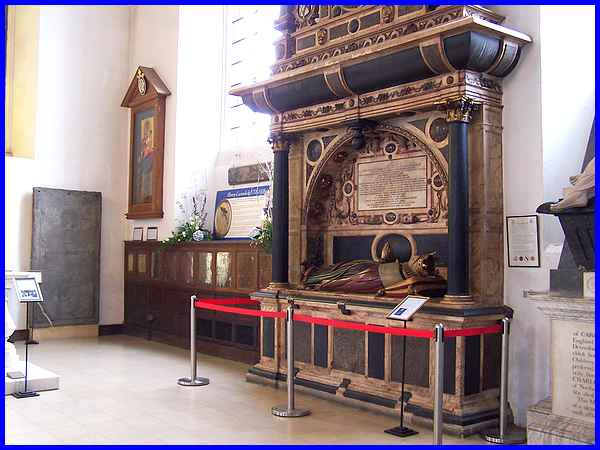
The south east corner of the cathedral is known as the Cavendish
Area and contains a number of interesting features not least
among them, the Bess of Hardwick memorial. Bess, or to give her
her full title, Elizabeth, Countess of Shrewsbury, is buried
in the vault below the elaborate memorial in what is now St Katharine's
Chapel. A much humbler monument in the same area and seen here
on the left of the above image is the tombstone of the Derby
artist Joseph Wright. This was moved to the cathedral in 2002
from St Alkmund's Church and is known to be an eighteenth century
re-use of a medieval vault marker.
|

In front of the Cavendish Area is the lectern on the right whilst
on the opposite side is the pulpit both of which are worthy of
closer inspection to appreciate the craftsmanship involved in
their construction.
|

Behind the Bakewell Screen is the chancel where morning and evening
prayer is celebrated daily and this is also where the Bishop's
throne is situated on the north side.
|

Holy Communion is also celebrated on a daily basis at the altar
which as the Walk Around Plan states is at the heart and focus
of the cathedral.
|
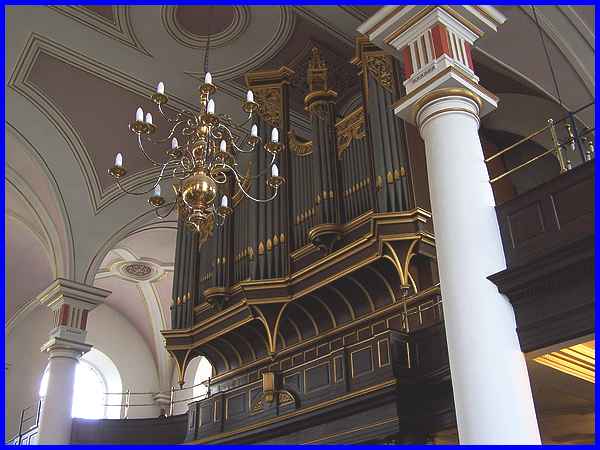
The organ in the cathedral positioned over the main entrance
was built in 1939 by John Compton (1865 - 1957) a pipe organ
builder born in Newton Burgoland, Leicestershire and who operated
his business from both Nottingham and London. He also built cinema
organs but his cathedral organ at Derby was without a case until
1963 due to the intervening war. Several additions and modifications
took place until it was given a complete overhaul in 1992.
|
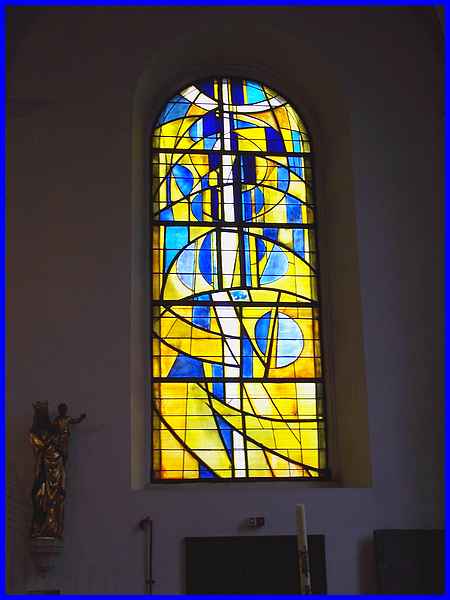
Derby Cathedral is also noted for its modern stained glass windows
from 1965 designed by Welsh artist Ceri Richards (1903 - 1971)
and whilst traditional stained glass windows are more to my taste,
Richards' windows in the cathedral of which the above is one
example, are fine examples of his work..
As would be expected there is much more to the cathedral
than can be covered in these few images and notes and two good
sources of information are the Derby Cathedral website and a Wikipedia article. As we started this part
with a brief look at the tower, so we'll finish it with another
mention. Since 2006 Peregrine Falcons have nested there and have
been the focus of much interest both on site and via webcams
on the internet. Click the Derby Cathedral Peregrine Project for more
information.
|

